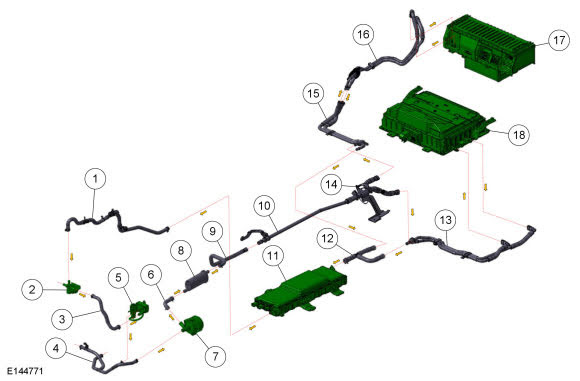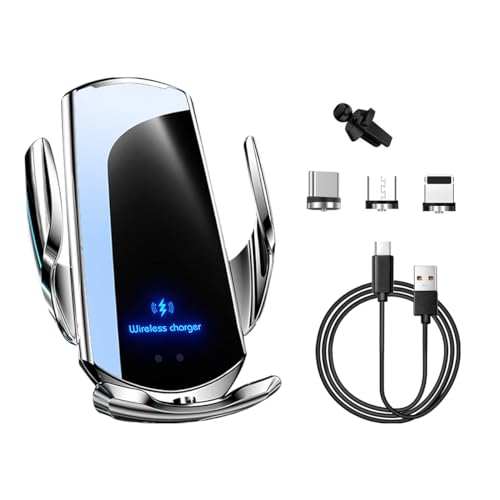We know that our high voltage lithium batteries are sensitive to temperature, particularly during charging. So a good battery thermal management system is key to its longevity.
I was browsing through the 2014 service manual and came across this diagram.

This is the cooling/heating loop for the batteries.
Points of interest are numbers 10 through 18.
Briefly, temperature adjusted coolant flows through 10 from left to right.
It then flows to 14 where it is split into two paths.
One path, 13, takes the coolant to the lower battery pack, 18, where the coolant loops through the pack, and returns back to 13.
The other path, 15, takes the coolant up to 16, and then up some more to the upper battery pack, 17, where the coolant loops through the pack, and returns back to 16, and down to 15.
The two paths rejoin at 12, where the coolant that has passed through both packs goes through the charger, 11, from right to left.
In this system, the packs are not cooled in series, but rather in parallel. Parallel cooling is used by other manufacturers lithium battery packs, but what makes Fords different is that there is a pressure difference between the packs because the coolant has to flow uphill to the upper pack.
Ok, so what does this mean? At 14, the amount of pressure necessary to pump the coolant up to and through the upper pack is greater than to do the same for the lower pack. This means that the flowrate to the upper pack is less than that for the lower pack. Cooling and heating works better for the lower pack than for the upper pack.
If you were to have air bubbles in your coolant, they would have a tendency to hang around in the upper pack with its lower flowrate, while being pushed through the lower pack with its higher flowrate. Now let say you get a lot of air bubbles, and maybe because the battery pack gets warm, it makes those air bubbles expand. It follows that the pressure starts to increase in the upper pack, and this pressure restricts the coolant from being pumped up there.
The lower pressure path is for the coolant to go to the lower pack.
So to make a long story short, the upper pack will not get proper thermal management, while the lower pack will.
The solution is to make sure that there are no air bubbles in the coolant loop, and if any air bubbles are in the upper pack, they are removed.
It might be that the Ford Engineers put a restrictor on the lower pack so that the pressure to move coolant through it is the same as for the upper pack. But maybe they didn't.
I was thinking that possibly when the 2012 and 2013 year vehicles were being made, they did not do a proper vacuum air purge from the coolant loops, and over time, this affected thermal management of the upper pack, and caused overall battery degradation.
Additionally, if any year vehicle had a breach in the coolant loops and air got in, and that air was not properly purged out, this same situation could occur. I did a vacuum air purge of my 2017, just for ***** and grins, a bit of air came out, and dropped the level in the degas tank. To my knowledge no service had been done to the thermal management system.
Like I said, something to consider.
I was browsing through the 2014 service manual and came across this diagram.

This is the cooling/heating loop for the batteries.
Points of interest are numbers 10 through 18.
Briefly, temperature adjusted coolant flows through 10 from left to right.
It then flows to 14 where it is split into two paths.
One path, 13, takes the coolant to the lower battery pack, 18, where the coolant loops through the pack, and returns back to 13.
The other path, 15, takes the coolant up to 16, and then up some more to the upper battery pack, 17, where the coolant loops through the pack, and returns back to 16, and down to 15.
The two paths rejoin at 12, where the coolant that has passed through both packs goes through the charger, 11, from right to left.
In this system, the packs are not cooled in series, but rather in parallel. Parallel cooling is used by other manufacturers lithium battery packs, but what makes Fords different is that there is a pressure difference between the packs because the coolant has to flow uphill to the upper pack.
Ok, so what does this mean? At 14, the amount of pressure necessary to pump the coolant up to and through the upper pack is greater than to do the same for the lower pack. This means that the flowrate to the upper pack is less than that for the lower pack. Cooling and heating works better for the lower pack than for the upper pack.
If you were to have air bubbles in your coolant, they would have a tendency to hang around in the upper pack with its lower flowrate, while being pushed through the lower pack with its higher flowrate. Now let say you get a lot of air bubbles, and maybe because the battery pack gets warm, it makes those air bubbles expand. It follows that the pressure starts to increase in the upper pack, and this pressure restricts the coolant from being pumped up there.
The lower pressure path is for the coolant to go to the lower pack.
So to make a long story short, the upper pack will not get proper thermal management, while the lower pack will.
The solution is to make sure that there are no air bubbles in the coolant loop, and if any air bubbles are in the upper pack, they are removed.
It might be that the Ford Engineers put a restrictor on the lower pack so that the pressure to move coolant through it is the same as for the upper pack. But maybe they didn't.
I was thinking that possibly when the 2012 and 2013 year vehicles were being made, they did not do a proper vacuum air purge from the coolant loops, and over time, this affected thermal management of the upper pack, and caused overall battery degradation.
Additionally, if any year vehicle had a breach in the coolant loops and air got in, and that air was not properly purged out, this same situation could occur. I did a vacuum air purge of my 2017, just for ***** and grins, a bit of air came out, and dropped the level in the degas tank. To my knowledge no service had been done to the thermal management system.
Like I said, something to consider.



































